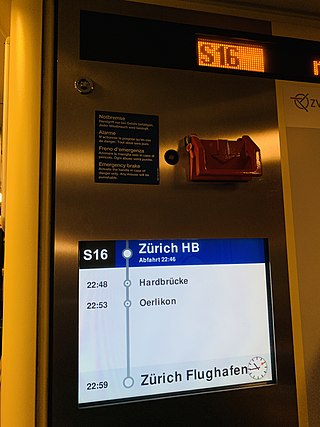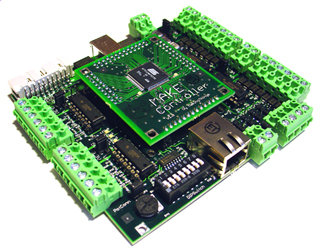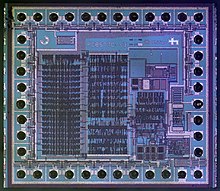
An electronic calculator is typically a portable electronic device used to perform calculations, ranging from basic arithmetic to complex mathematics.

A motherboard is the main printed circuit board (PCB) in general-purpose computers and other expandable systems. It holds and allows communication between many of the crucial electronic components of a system, such as the central processing unit (CPU) and memory, and provides connectors for other peripherals. Unlike a backplane, a motherboard usually contains significant sub-systems, such as the central processor, the chipset's input/output and memory controllers, interface connectors, and other components integrated for general use.

AVR is a family of microcontrollers developed since 1996 by Atmel, acquired by Microchip Technology in 2016. These are modified Harvard architecture 8-bit RISC single-chip microcontrollers. AVR was one of the first microcontroller families to use on-chip flash memory for program storage, as opposed to one-time programmable ROM, EPROM, or EEPROM used by other microcontrollers at the time.

The MSP430 is a mixed-signal microcontroller family from Texas Instruments, first introduced on 14 February 1992. Built around a 16-bit CPU, the MSP430 was designed for low power consumption, embedded applications and low cost.

A flat-panel display (FPD) is an electronic display used to display visual content such as text or images. It is present in consumer, medical, transportation, and industrial equipment.
4-bit computing is the use of computer architectures in which integers and other data units are 4 bits wide. 4-bit central processing unit (CPU) and arithmetic logic unit (ALU) architectures are those that are based on registers or data buses of that size. A group of four bits is also called a nibble and has 24 = 16 possible values, with a range of 0 to 15.

The HP-IL was a short-range interconnection bus or network introduced by Hewlett-Packard in the early 1980s. It enabled many devices such as printers, plotters, displays, storage devices, test equipment, etc. to be connected to programmable calculators such as the HP-41C, HP-71B and HP-75C/D, the Series 80 and HP-110 computers, as well as generic ISA bus based PCs.
A fourteen-segment display (FSD) is a type of display based on 14 segments that can be turned on or off to produce letters and numerals. It is an expansion of the more common seven-segment display, having an additional four diagonal and two vertical segments with the middle horizontal segment broken in half. A seven-segment display suffices for numerals and certain letters, but unambiguously rendering the ISO basic Latin alphabet requires more detail. A slight variation is the sixteen-segment display which allows additional legibility in displaying letters or other symbols.

The HP 200LX Palmtop PC, also known as project Felix, is a personal digital assistant introduced by Hewlett-Packard in August 1994. It was often called a Palmtop PC, and it was notable that it was, with some minor exceptions, a DOS-compatible computer in a palmtop format, complete with a monochrome graphic display, QWERTY keyboard, serial port, and PCMCIA expansion slot. The abbreviation "LX" stood for "Lotus Expandable".
A general-purpose input/output (GPIO) is an uncommitted digital signal pin on an integrated circuit or electronic circuit board which may be used as an input or output, or both, and is controllable by software.

A video display controller (VDC), also called a display engine or display interface, is an integrated circuit which is the main component in a video-signal generator, a device responsible for the production of a TV video signal in a computing or game system. Some VDCs also generate an audio signal, but that is not their main function. VDCs were used in the home computers of the 1980s and also in some early video picture systems.

The Hewlett-Packard Series 80 of small scientific desktop computers was introduced in 1980, beginning with the popular HP-85 targeted at engineering and control applications. They provided the capability of the HP 9800 series desktop computers with an integrated monitor in a smaller package including storage and printer, at half the price.

The Jornada was a line of personal digital assistants or PDAs manufactured by Hewlett-Packard. The Jornada was a broad product line that included Palm-Size PCs, Handheld PCs, and Pocket PCs. The first model was the 820, released in 1998, and the last was the 928 model in 2002 when Compaq and HP merged. The Jornada line was then succeeded by the more popular iPAQ model PDAs. All Jornada models ran Microsoft Operating Systems that were based on Windows CE.

HP Labs is the exploratory and advanced research group for HP Inc. HP Labs' headquarters is in Palo Alto, California and the group has research and development facilities in Bristol, UK. The development of programmable desktop calculators, inkjet printing, and 3D graphics are credited to HP Labs researchers.

In electronics, an LED circuit or LED driver is an electrical circuit used to power a light-emitting diode (LED). The circuit must provide sufficient current to light the LED at the required brightness, but must limit the current to prevent damaging the LED. The voltage drop across a lit LED is approximately constant over a wide range of operating current; therefore, a small increase in applied voltage greatly increases the current. Datasheets may specify this drop as a "forward voltage" at a particular operating current. Very simple circuits are used for low-power indicator LEDs. More complex, current source circuits are required when driving high-power LEDs for illumination to achieve correct current regulation.
The Hitachi HD44780 LCD controller is an alphanumeric dot matrix liquid crystal display (LCD) controller developed by Hitachi in the 1980s. The character set of the controller includes ASCII characters, Japanese Kana characters, and some symbols in two 40 character lines. Using an extension driver, the device can display up to 80 characters. Numerous third-party displays are compatible with its 16-pin interface and instruction set, making it a popular and cheap LCD driver.

A LED display is a flat panel display that uses an array of light-emitting diodes (LEDs) as pixels for a video display. Their brightness allows them to be used outdoors where they are visible in the sun for store signs and billboards. In recent years, they have also become commonly used in destination signs on public transport vehicles, as well as variable-message signs on highways. LED displays are capable of providing general illumination in addition to visual display, as when used for stage lighting or other decorative purposes. LED displays can offer higher contrast ratios than a projector and are thus an alternative to traditional projection screens, and they can be used for large, uninterrupted video walls. microLED displays are LED displays with smaller LEDs, which poses significant development challenges.

A single-board microcontroller is a microcontroller built onto a single printed circuit board. This board provides all of the circuitry necessary for a useful control task: a microprocessor, I/O circuits, a clock generator, RAM, stored program memory and any necessary support ICs. The intention is that the board is immediately useful to an application developer, without requiring them to spend time and effort to develop controller hardware.

LPC is a family of 32-bit microcontroller integrated circuits by NXP Semiconductors. The LPC chips are grouped into related series that are based around the same 32-bit ARM processor core, such as the Cortex-M4F, Cortex-M3, Cortex-M0+, or Cortex-M0. Internally, each microcontroller consists of the processor core, static RAM memory, flash memory, debugging interface, and various peripherals. The earliest LPC series were based on the Intel 8-bit 80C51 core. As of February 2011, NXP had shipped over one billion ARM processor-based chips.















